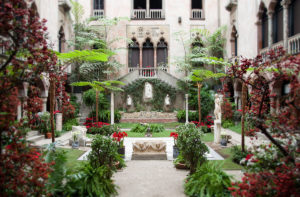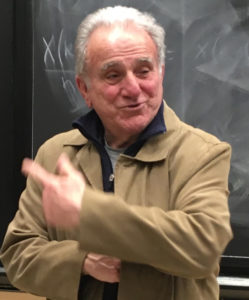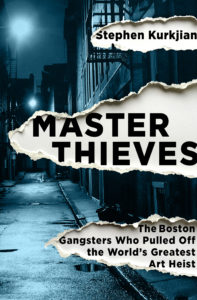Treasure Hunt
Appeared in the Boston Globe, March 14, 2015
If you’re one of those readers who demand gift-wrapped endings to books, you might be frustrated by Master Thieves.

The book does not solve the mystery of one of the world’s biggest art heists — the theft of $500 million worth of artwork from the Isabella Stewart Gardner Museum. But it does offer a pretty good road map for the FBI to follow 25 years later and rewards readers with a compelling story about Boston’s criminal underbelly.
Author Stephen Kurkjian, who won three Pulitzer Prizes as a Globe investigative reporter, has pulled together a cast of characters that would make Martin Scorsese swoon in admiration. There are so many crime-world figures with their fingers in this story that the book is like a GoodFellas/The Departed double feature.

It starts with a low-level thief who first began dreaming of robbing the museum while a child. Even as a kid, Louis Royce could tell that museum security was lax. During one of his youthful visits, he hid in one of the galleries and spent the night there. No one found him. For most of his criminal career, Royce would tell anyone in the Boston crime community — from petty crooks to underworld aristocracy — that the Gardner was ripe for picking. Royce’s tips planted the seed for the caper in the minds of the perpetrators, according to Kurkjian.
The Gardner is one of Boston’s treasures, but, as Kurkjian notes, its world-class collection was housed in a building whose security system was laughable. Even the museum staff was aware of the fact, but its board of directors was reluctant to spend when it came to security.
When opened in 1903, the Gardner was, for a time, the largest privately-owned museum in the United States and boasted priceless canvases by Rembrandt, Degas, Vermeer, and other masters.
Yet when the museum was hit in 1990, there wasn’t even a central fire-alarm system. The fire alarms were independent buzzing wall models, like those ones homeowners can buy at Walmart or Home Depot.

As for the burglar alarm, there was only one button that would trigger it and that was tucked underneath the counter at the front desk.
To top it all off, back then at least, there was a chance that the nighttime security staff might be stoned.
What happened on that March night in 1990 is still partially a mystery all these years later. What’s known is that two thieves in police uniforms appeared at the front door and knocked, pulling security guard Richard Abath away from his desk — and from the alarm button. The thieves cuffed Abath and a second security guard, swaddled their heads in duct tape, and stashed them in the basement.
At first, the two guards thought they were being arrested until one of the cops explained: “This is a robbery, gentlemen . . . Don’t give us any problems, and you won’t get hurt.”
The most celebrated painting they seized, Rembrandt’s “The Storm on the Sea of Galilee,’’ was 4 feet by 5 feet. Even cut from its frame, it must have been bulky and difficult for the thieves to take outside to their waiting van. Still, they took 13 works of art in total, and no one saw them leave.
When the museum staff arrived the next morning, the search began. Kurkjian’s cast of characters represents a who’s who of Boston’s underworld: gang leaders Ralph Rossetti and Vincent Ferrara, and David Turner, who was convicted in an armored-car headquarters robbery scheme and whose Cheshire-cat smile seemed to indicate involvement in the heist. Of course, James “Whitey” Bulger makes a cameo appearance. He apparently had nothing to do with the theft, but since it happened on his turf, he felt the desire to “wet his beak.”
Kurkjian constructs a thrilling narrative from the FBI investigation and the buzz about the theft in the criminal community. He recounts all the major theories, talks to some of the would-be masterminds, and seems to have a pretty good idea who might be responsible: Robert Donati, the driver for mob-leader Ferrara who, Kurkjian says, wanted to use the art as a bargaining chip to spring his boss from prison. Donati was murdered the year after the Gardner caper, so the answers to a lot of questions may have died with him.
But the FBI, to Kurkjian’s frustration, avoids taking a fresh look at the crime. Kurkjian suggests that the FBI use social media to crowdsource the location of the masterpieces. It helped find Bulger and the Marathon bombers. Why not art thieves?
Kurkjian has shared evidence and theories with the FBI, but finds the agency unwilling to consider any new narrative. To Kurkjian, this is an outrage. “It is a disgrace that wouldn’t be tolerated in European countries,” he writes. Art should be recognized as a national treasure, not just another commodity.
And what of the artwork? Is it rolled up and stashed under the floor of someone’s backyard shed?
We don’t get the definitive answer in Master Thieves. What we do get is a great mystery story well told. In this case, the story is about the journey, not the destination.
